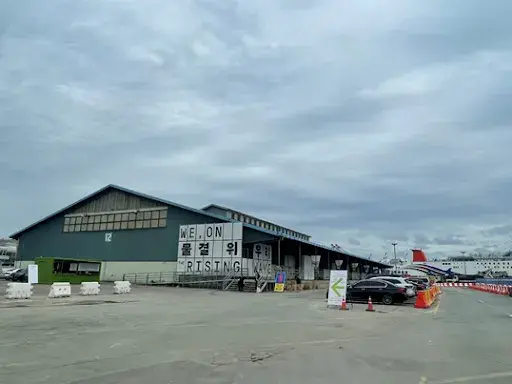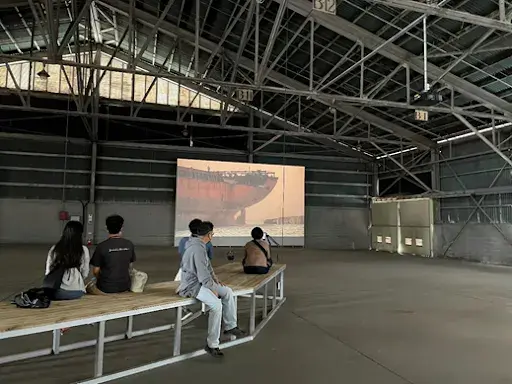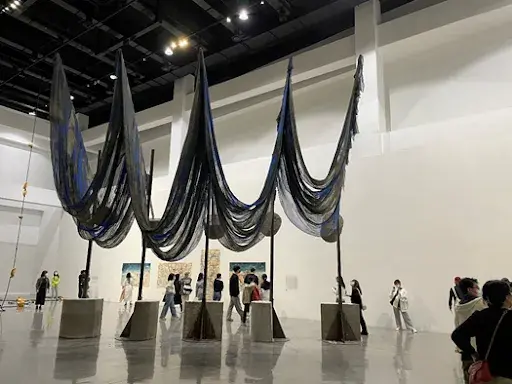Review of 2022 Busan Biennale: The ‘Wave’ of Art That Made Us Look at the Port City of Busan Again
Busan is a port city. This established fact was brought up because the 2022 Busan Biennale particularly explored this element. The 2022 Busan Biennale reflected trends of other recent shows, such as the locality and ecological affinity of the venue. Accordingly, many works had the characteristics of Busan’s sea and port, revealing modern and contemporary history, traces of migration and labor, and the lives of women. For me, whose hometown is Busan, the 2022 Busan Biennale created a feeling of traveling in a familiar yet unfamiliar world.
The 2022 Busan Biennale met visitors at the Pier 1 of Busan Port exhibition hall, the Museum of Contemporary Art Busan, Choryang mountain corridor housing, and Yeongdo shipyard. Around 80 artists from 64 teams and 25 countries presented 239 works. These works contained stories engraved or hidden in the history and urban structure of Busan after modern times. This is related to the theme of the biennale: ‘We, on the rising wave.’ The ‘wave’ in the theme has various implications. According to the organizers, the word refers to people who have been flowing into and pushed into Busan for a long time, altering its history, connection with the world, and geographical features.

Above all, the most impressive space of the event was the Pier 1 of Busan Port exhibition hall, which symbolizes the ‘port city of Busan.’ In the past, the former port warehouse measured about 4,100 square meters. Pier 1, created in 1912, was the gateway from Busan to the world and the passage of migration. In other words, it was the starting point of the modern city of Busan. It served as a port, trade, and passenger dock until 1937. During the Japanese colonial period, Pier 1 was the base of the Japanese invasion and transportation routes. After liberation, especially during the Korean War, it was in charge of procuring war supplies and transporting returnees and refugees. As such, this area has indispensable historical value in Busan’s modern and contemporary history. Korea’s second largest city was constantly in contact with shifting trends in the economy, labor, and migration.
Before stepping into Pier 1 exhibition hall, I was curious. Which works would adapt to a huge warehouse that far exceeds the human scale? The exhibition hall was magnificent. Unlike other art galleries, there was no boundary in the exhibition space. Nevertheless, the works did not violate other viewing areas.
The first work at the entrance of the exhibition hall was Megan Cope’s Kinyingarra Guwinyanba (Off Country). Cope, an Aboriginal artist from Quandamooka Island in Australia, exhibited a work that featured trees from the ceiling and connected oyster shells. This oyster farming form belongs to the Aboriginal people of Australia. In the past, they planted wooden pillars on the coast of Australia and created an environment where oysters grew. Oysters were their staple food and a sign of sovereignty. The oyster shells used in the work were collected in Jinhae, South Gyeongsang Province, which accounts for 85% of Korea’s oyster production. The artist said the work contains the colonial pain experienced by both Quandamooka and Korea. The work reflected the lives of the native residents of Quandamooka and Korea, who share a history of losing their sovereignty and nature-friendly way of life. The oyster shells hanging from trees revealed the people’s poor lives and environmental problems. The two distant spaces were connected, and the memories of a desperate life were revealed through the power of art.

The story of Hira Navi, a visual artist from Pakistan, was also interesting. The container ship Ocean Master, built in Jinhae, South Korea in 1995, reached Gadani, Pakistan, in 2018. Gadani is South Asia’s largest ship dismantling site. The workers are gathered near this ship. Hira Navi’s presented video, All That Perishes at the Edge of Land, connects the process of deindustrialization in the Northern Hemisphere and the harsh daily life experienced by workers in the Southern Hemisphere. The workers, exposed to danger, were dismantling the ship and sorting out waste and recycled materials. Their low-wage labor was the result of structural violence imposed by economic colonization. The sea was also a victim. The dismantling of the ship destroyed the sea environment and fishing village ecosystem. It wasn’t just the ship that had died.
As such, the Pier 1 exhibition hall clearly revealed the port and the struggles of industry, history, and labor surrounding Busan through the installation and video of specific objects. There was nothing abstract or complicated. It was another Busan and another sea for me. The Museum of Contemporary Art Busan in Eulsukdo Island, where the exhibition was held, was also intense. A charcoal painting by Minkyung Kam vividly extended Busan in the past. A Song of Dongsuk, Zero’clock, and The Tides symbolically revealed the difficult times. The smell of poverty on the painting evoked adversity, reminding viewers that hope and despair, life and death coexist. The fragments of individual memories were eventually proved to be of the times. The fact that I was born and raised in a land with sad memories passed through my body.

It was a biennale that made me consider Busan again. Art is not free from the magnetic field of time and place, nor am I saying that art is trapped in times and places. Breakthroughs and freedoms in art are also possible when one recognizes the given magnetic field and overcomes it. However, there may be limitations because the 2022 Busan Biennale focused on the place and life of Busan in the past. Visual arts with specific materials and physical properties may have overwhelmed the exhibitions. The port city of Busan is in the midst of changes to attract the 2030 Busan World Expo. We don’t know what will change in the future, but Busan will change anyway. This is why I look forward to the next Busan Biennale in two years.









